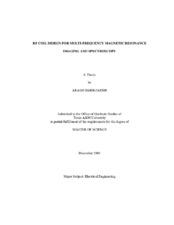| dc.description.abstract | Magnetic Resonance Spectroscopy is known as a valuable diagnostic tool for
physicians as well as a research tool for biochemists. In addition to hydrogen (which is
the most abundant atom with nuclear magnetic resonance capability), other species (such
as 31P or 13C) are used as well, to obtain certain information such as metabolite
concentrations in neural or muscular tissues. However, this requires nuclear magnetic
resonance (NMR) transmitter/receivers (coils) capable of operating at multiple
frequencies, while maintaining a good performance at each frequency. The objective of
this work is to discuss various design approaches used for second-nuclei RF (radio
frequency) coils, and to analyze the performance of a particular design, which includes
using inductor-capacitor (LC) trap circuits on a 31P coil. The method can be easily
applied to other nuclei. The main advantage of this trapping method is the enabling
design of second-nuclei coils that are insertable into standard proton coils, maintaining a
near-optimum performance for both nuclei. This capability is particularly applicable as
MRI field strengths increase and the use of specialized proton coils becomes more
prevalent. A thorough performance analysis shows the benefit of this method over other designs, which usually impose a significant signal-to-noise (SNR) sacrifice on one of the
nuclei.
A methodology based on a modular coil configuration was implemented, which
allowed for optimization of LC trap decoupling as well as performance analysis. The 31P
coil was used in conjunction with various standard 1H coil configurations
(surface/volume/array), using the trap design to overcome the coupling problem
(degraded SNR performance) mentioned above. An analytical model was developed and
guidelines on trap design were provided to help optimize sensitivity. The performance
was analyzed with respect to the untrapped case, using RF bench measurements as well
as data obtained from the NMR scanner. Insertability of this coil design was then
verified by using it with general-purpose proton coils available. Phantoms were built to
mimic the phosphorus content normally found in biologic tissues in order to verify
applicability of this coil for in vivo studies. The contribution of this work lies in the
quantification of general design parameters to enable “insertable” second-nuclei coils, in
terms of the effects on SNR and resonance frequency of a given proton coil. | en |


